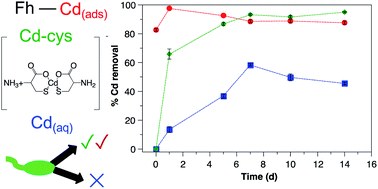Complexation by cysteine and iron mineral adsorption limit cadmium mobility during metabolic activity of Geobacter sulfurreducens†
Abstract
Cadmium (Cd) adversely affects human health by entering the food chain via anthropogenic activity. In order to mitigate risk, a better understanding of the biogeochemical mechanisms limiting Cd mobility in the environment is needed. While Cd is not redox-active, Cd speciation varies (i.e., aqueous, complexed, adsorbed), and influences mobility. Here, the cycling of Cd in relation to initial speciation during the growth of Geobacter sulfurreducens was studied. Either fumarate or ferrihydrite (Fh) was provided as an electron acceptor and Cd was present as: (1) an aqueous cation, (2) an aqueous complex with cysteine, which is often present in metal stressed soil environments, or (3) adsorbed to Fh. During microbial Fe(III) reduction, the removal of Cd was substantial (∼80% removal), despite extensive Fe(II) production (ratio Fe(II)total : Fetotal = 0.8). When fumarate was the electron acceptor, there was higher removal from solution when Cd was complexed with cysteine (97–100% removal) compared to aqueous Cd (34–50%) removal. Confocal laser scanning microscopy (CLSM) demonstrated the formation of exopolymeric substances (EPS) in all conditions and that Cd was correlated with EPS in the absence of Fe minerals (r = 0.51–0.56). Most notable is that aqueous Cd was more strongly correlated with Geobacter cells (r = 0.72) compared to Cd–cysteine complexes (r = 0.51). This work demonstrates that Cd interactions with cell surfaces and EPS, and Cd solubility during metabolic activity are dependent upon initial speciation. These processes may be especially important in soil environments where sulfur is limited and Fe and organic carbon are abundant.



 Please wait while we load your content...
Please wait while we load your content...